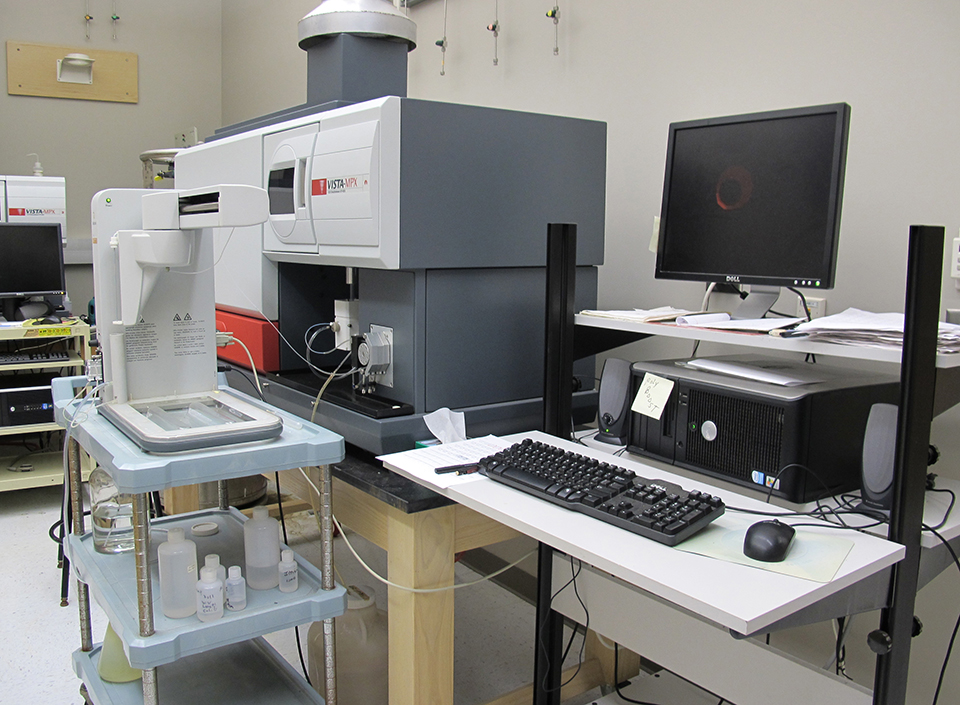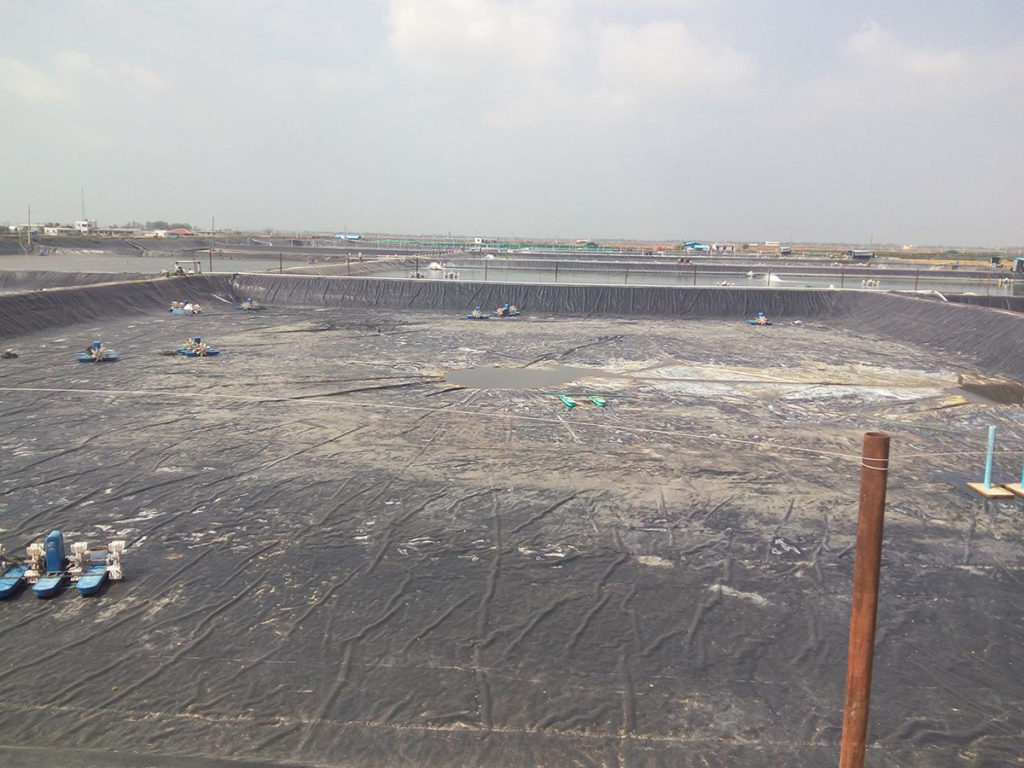High concentrations negatively impacts water quality

After pond construction is finished and aquaculture operations begin, however, dead plankton settle from the water column onto the bottom. Other sources of organic matter – including organic fertilizers, unconsumed feed, feces of culture animals, and exoskeletons of molting shrimp – also settle to pond bottoms.
Shrimp and fish farmers widely believe that organic matter accumulates to high concentrations in pond bottoms and causes sediment quality to deteriorate and negatively impact water quality.
Flocculent layer
Fine mineral particles also settle to the bottom and mix with the organic matter to form a flocculent layer above the sediment-water interface. The flocculent layer also contains microorganisms that rapidly decompose a portion of the organic matter.
The more resistant organic remains mix with the upper layer of soft, fluid sediment. This top layer usually is aerobic (contains oxygen) in the upper few millimeters and anaerobic (without oxygen) at greater depths. Anaerobic conditions develop because microorganisms decomposing organic matter in the sediment remove dissolved oxygen from sediment pore water faster than dissolved oxygen can enter by diffusion and infiltration.
Effect on water quality
The flocculent layer and fluid sediment layer influence water quality by consuming dissolved oxygen, and releasing and adsorbing nutrients. Toxic microbial metabolites can originate from microbial activity in anaerobic zones of the flocculent layer or soft sediment and enter the water.
The soft sediment usually is no more than 5 cm thick. Deeper sediment is less fluid than the upper layer, but often has an organic matter concentration similar to the soft sediment. It usually is anaerobic, but does not readily exchange substances with the pond water.
Sediment profile and fractions
Researchers have suggested that the flocculent layer, soft sediment, and deeper sediment be called the F, S, and M horizons, respectively. The original pond bottom soil below the M horizon is called the P horizon, and the transition layer between the M and P horizons can be called the T horizon. All the horizons combined are known as the sediment profile.
Sediment organic matter can be separated into two basic fractions: labile organic matter that decomposes very quickly and refractory organic matter that decomposes more slowly. During degradation of an organic residue, the labile fraction quickly is consumed by microbial activity, but the refractory fraction resists decay and accumulates in the sediment. The oxygen demand per unit of organic matter is greater in the flocculent layer than the soft sediment and declines further with increasing depth into the sediment.
Organic carbon concentration
Organic matter has a high concentration of carbon that averages 58 percent. Concentrations of sediment organic carbon usually are below 4 percent in pond bottoms, and in new ponds, the soil can contain less than 0.25 percent organic carbon. The amount of organic carbon in pond bottoms can increase as a result of increasing carbon concentration in the sediment, increasing depth of sediment, or both.
Equilibrium concentration
Organic carbon concentration in sediment eventually reaches an equilibrium concentration that depends upon the organic matter and nutrient inputs to the pond, sediment pH, temperature, amount of mechanical aeration, and other factors.
This equilibrium is reached rather quickly. For example, organic carbon concentrations in experimental earthen ponds of different ages at Auburn University in Alabama, USA were measured as follows 2 years old, 2.6 percent; 52 years old, 2.8 percent; 23 years old, 3.1 percent. Tilapia ponds in Thailand of 1 to 10 years old averaged 1.9 percent soil organic carbon, while those 31-40 years old had an average soil organic carbon of nearly 2.5 percent.
The mass of organic matter in pond bottoms increases with time as sediment depth becomes greater. For example, the depth of sediment containing 2 to 3 percent organic carbon in ponds at Auburn University was 5 cm in 2-year-old ponds, 25 cm in 23-year-old ponds, and 45 cm in 52-year-old ponds. However, only organic matter in the flocculent layer and top few centimeters of the bottom soil affect pond water quality.
Organic matter decomposition
The main problems from organic matter decomposition in pond bottoms are the removal of dissolved oxygen from the water, anaerobic conditions at the sediment-water interface, and release of toxic metabolites such as ammonia, nitrite, and hydrogen sulfide into the overlying water. These problems can happen in new ponds with low soil organic matter concentrations under conditions of high feeding rates, abundant phytoplankton, and a thick flocculent layer. It also can happen in ponds without these factors, provided bottom soils have high concentrations of organic matter.
The flocculent layer cannot be sampled easily, and samples usually consist of material from the upper sediment layer. Methods for measuring sediment organic matter or carbon concentrations do not distinguish between labile and refractory organic matter. This makes it difficult to interpret soil organic matter concentrations in samples taken from the bottoms of aquaculture ponds. However, most of the labile organic matter is in the upper 5-cm sediment layer.
When ponds are drained for harvest, the flocculent layer and some of the fine particles in the sediment are released in effluent. The ideal time to sample pond bottom soils for organic matter analysis is soon after draining for harvest. Table 1 shows the classification of bottom soil organic matter concentrations for samples taken at this time.
Boyd, Classification of bottom soil, Table 1
| Organic Carbon (%) | Comment |
|---|
Organic Carbon (%) | Comment |
|---|---|
| > 15 purposes | Organic soil, not good for aquaculture |
| 3.1-15 | Mineral soil with high organic matter |
| 1.0-3.0 | Mineral soil, moderate organic matter content, best range for aquaculture |
| < 1.0 | Mineral soil, low organic matter content |
Soil organic matter decomposes best in aerobic soil with a pH of 7 to 8. Thus, drying the pond bottom between crops, applying liming materials to acidic soils, and tilling with a disk harrow to promote the contact of soil with air accelerates organic matter decomposition. Pond bottoms seldom should be dried for more than 10 to 15 days. Most of the labile organic matter will decompose within this length of time. After two or three weeks, soils can become so low in moisture content that microbial activity stops.
Soil analyses can be made just before refilling ponds to determine how much organic matter remains. Usually, the decline in organic matter concentration is small, but most of the decline represents labile organic matter, and soil quality is much better than it was at the end of the previous crop.
Sample collection and analysis
Samples for sediment organic matter should be taken from the upper 5-cm layer and from 10 to 20 places throughout each pond. A convenient device for taking sediment samples is a clear plastic, 5-cm-diameter tube. The tube can be forced into the bottom to the 5-cm mark and removed with a plug of sediment intact.
The plugs should be knocked from the tube into a plastic bucket and thoroughly mixed to provide a composite sample for analysis. The sample can be sent to a commercial testing laboratory for analysis of organic carbon by the Walkley-Black method of dichromate oxidation.
At some laboratories, total carbon concentrations are determined by induction furnace analyzers which measure both organic carbon and carbon in carbonate. In pond bottom soils with high concentrations of carbonates, total carbon concentration is not a good estimator of organic carbon.
Hach Chemical Co. of Loveland, Colorado, USA markets a soil-testing kit for organic carbon analysis by the Walkley-Black procedure. A recent study showed this kit provides sediment organic carbon estimates approximately equal to those obtained by the standard Walkley-Black method.
(Editor’s Note: This article was originally published in the April 2003 print edition of the Global Aquaculture Advocate.)
Now that you've reached the end of the article ...
… please consider supporting GSA’s mission to advance responsible seafood practices through education, advocacy and third-party assurances. The Advocate aims to document the evolution of responsible seafood practices and share the expansive knowledge of our vast network of contributors.
By becoming a Global Seafood Alliance member, you’re ensuring that all of the pre-competitive work we do through member benefits, resources and events can continue. Individual membership costs just $50 a year.
Not a GSA member? Join us.
Author
-

Claude E. Boyd, Ph.D.
Professor, Department of Fisheries and Allied Aquacultures
Auburn University
Auburn, Alabama 36849 USA
Tagged With
Related Posts

Health & Welfare
Ammonia toxicity degrades animal health, growth
Ammonia nitrogen occurs in aquaculture systems as a waste product of protein metabolism by aquatic animals and degradation of organic matter, or in nitrogen fertilizers. Exposure can reduce growth and increase susceptibility to diseases in aquatic species.

Responsibility
Accuracy of custom water analyses varies
The reliability of trace element analyses reported by custom laboratories cannot be checked by simple techniques, and results may not always be accurate. One should check the reliability of major ion analyses by determining the charge balance and comparing the measured total ion concentration with the total ion concentration estimated from conductivity.

Responsibility
Defining ranges for water quality variables presents complex, challenging process
The creation and application of reference tables for acceptable concentration ranges of physical and chemical water quality variables for culture organisms would be challenging due to the differing tolerances found among the many farmed species.

Responsibility
Appraising pond liners for shrimp culture
The use of plastic-lined ponds by shrimp farmers can significantly improve production efficiency, support more production cycles per year, and higher mechanical aeration rates and stocking densities. The capital cost of lining ponds can be very significant, so a thorough feasibility analysis is recommended when considering this production tool.

